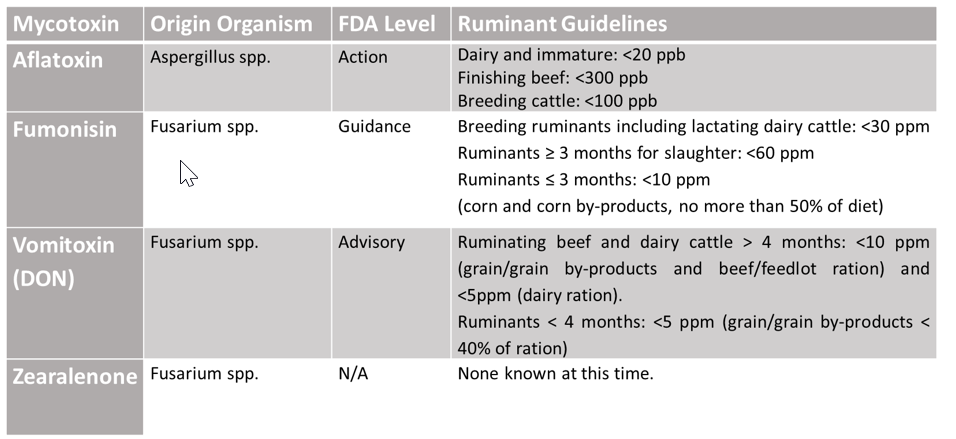What are mycotoxins and why do they matter? Fungi and mold can grow and proliferate in grains, silages, and other animal feed products either when plants are stressed, or during unsatisfactory growing conditions. While mold, in itself, can reduce the value of a feedstuff, many do not have risk to animal safety outside of the negative implications to feed quality and appearance. Nonetheless, some may produce compounds that are deleterious to food or feed safety, even at low levels. These secondary metabolites, are called mycotoxins.
In general, molds grow in a temperature range of 50-104◦ F and often the proliferation of mycotoxins is caused by a stressor of some type, which could be drought, heat, insect infestation, or excessive moisture. The mature ruminant animal is unique because it has a giant fermentation vat called the rumen that can insulate the animal itself from some of these mycotoxins. In fact, some of the rumen microbes can detoxify the toxins or convert them to less potent or inactive metabolites. However, this isn’t the case for all mycotoxins and younger ruminants (< 4 months of age) or pre-ruminants that are more susceptible than their adult counterparts; primarily because of their underdeveloped rumen and immune system. Likewise, dairy cattle, because of their higher feed intakes, are possibly more susceptible than beef cattle.
There are over 400 known mycotoxins in most dairy and feedlot production systems and 4 mycotoxins are more common than others. These include aflatoxin, deoxynivalenol (DON/vomitoxin), fumonisin, and zearalenone. Of these, the FDA provides an action level for aflatoxin and guidance levels for DON and fumonisin, while at this time, no guidance is provided for zearalenone. Aflatoxin is the only mycotoxin in cattle feed where the FDA will take regulatory action, because of its capability to pass through to milk, and it being a known carcinogen to humans. Every load of milk is tested for aflatoxin and will be dumped if levels are at or above 0.5 PPB. Like aflatoxin, fumonisin can also pass through the rumen and impact the ruminant animal. Animal impacts for aflatoxin and fumonisin can include reduced intake, liver impairment, and lost production. Conversely, vomitoxin and zearalenone are converted to other compounds in the rumen that are either less potent or that are less likely to be absorbed across the rumen wall. Because of this, in cases where only one of these mycotoxins is present, animal impacts may be less obvious. Nonetheless, mycotoxins like to travel together and there will generally be two or more present in contaminated feedstuffs. In these cases, prolonged exposure can lead to symptoms listed above as well as reproduction issues and overall reduced immunity. The more stressful the production system, the more likely animals will be to exhibit signs of mycotoxin insult.
Table 1. FDA Action and Guidance Levels for Mycotoxins in Ruminant Feeds and Diets
Producers should know and understand the quality of feeds they use to ensure animal health and production goals are met. When testing for mycotoxins, there are quick tests (ELISA) available that are OK for screening some products, but in general, and particularly with feed products, wet chemistry tests (high performance liquid chromatography or thin-layer chromatography) should be used. Commercial labs should be able to help verify what method is appropriate for the product you are testing.
Because mycotoxins can be produced in the field, or later in storage, there are multiple types of mitigation strategies. From a management standpoint, feeds should be used on a “first in, first out” basis, feed bunks should be cleaned regularly, moldy feeds should be avoided, and if feeds are known to be contaminated, they should be used at low levels in the diet. Likewise, when putting up silages, good management strategies to remove oxygen quickly, reduce pH quickly, coverage of piles, and maintaining a nice face should all be employed. There are also mold inhibitors that can be used, especially for wet feeds or silages, such as propionic acid, ammonia, or enzymatic additives, in addition to dietary additives that can potentially bind or modulate mycotoxins. Other mitigation strategies can be employed when grains and other raw ingredients are coming into elevators for storage or plants where they may be further processed. These include optical sorting, mechanical separation, density segregation, chemical deactivation, and thermal treatments.
Cargill Branded Feeds wants to ensure we deliver on our promise to provide high quality, safe feeds to our customers and because of this we have multiple mitigation strategies we employ. These include strategies to safeguard against contamination of grain on the front end (strategic sourcing and screening), density segregation strategies in process, and continual screening of our products on the backend. We undertake great efforts to understand the impacts of mycotoxins to our customers to ensure our brands exceed quality standards.
References:
Fink-Gremmels, J. 2008. Mycotoxins in Cattle Feeds and Carry-over to Dairy Milk: A Review. Food Additives & Contaminants: Part A. 25:2, 172-180.
NGFA Industry Notification: FDA Guidance on Mycotoxins. May 2019. National Grain and Feed Association. Washington, D.C.
Whitlow, L.W. and W. M. Hagler. 2005. Mycotoxins in Dairy Cattle: Occurrence, Toxicity, Prevention, and Treatment. Proc. Southwest Nutr. Cond: 124-138.
Cargill Branded Feed creates proprietary feed ingredients to improve digestive health and performance for production animals in the beef, dairy, aquaculture and pet food markets. Branded Feed is a segment of Cargill Starches, Sweeteners & Texturizers (CSST).


 Download as pdf
Download as pdf

